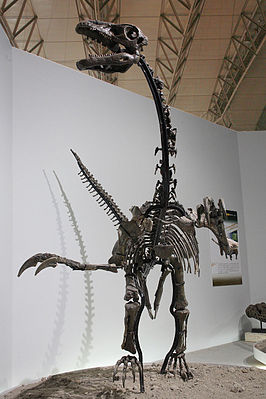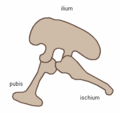Therizinosauroidea
| Therizinosauroidea | ||||||||||||
|---|---|---|---|---|---|---|---|---|---|---|---|---|

Skeletal reconstruction of Erliansaurus |
||||||||||||
| Temporal occurrence | ||||||||||||
| Lower Cretaceous to Upper Cretaceous ( Barremium to Maastrichtian ) | ||||||||||||
| 130.7 to 66 million years | ||||||||||||
| Locations | ||||||||||||
| Systematics | ||||||||||||
|
||||||||||||
| Scientific name | ||||||||||||
| Therizinosauroidea | ||||||||||||
| Russell & Dong , 1993 |
The Therizinosauroidea were a group of two to eight meter long theropod dinosaurs from the Cretaceous region of North America and Asia. The most striking feature of these bipedal (two-legged) dinosaurs are the very long clawed front limbs .
The group was first reported in 1980 by the Mongolian paleontologists bars Bold and Pearl as Segnosauria described and, as a precise allocation was not possible to distinguish between lizards dinosaurs Beck (Saurischia) and Vogelbeck dinosaurs classified (Ornithischia). Later finds, including evidence of simple fletching , allowed the assignment to the theropods . Therizinosauroid fossils originate mainly from the Lower and Upper Cretaceous Asia ( China , Mongolia , Buryatia , Kazakhstan , Uzbekistan ). The genus Nothronychus is native to the western United States ( Utah , New Mexico ). A single mandibular fragment , described as an Eshanosaurus , could extend the group's stratigraphic reach into the Hettangian (earliest Lower Jurassic ). The Therizinosauroidea are defined as the clade (family line) of Therizinosaurus and Beipiaosaurus , their last common ancestors and all their descendants.
features
skull
The skull of the Therizinosauroidea is known only from Alxasaurus , Beipiaosaurus and Erlikosaurus . It was unusually small for a theropod skull compared to the body. The cranial bones were highly pneumatized (with air-filled cavities). The intermaxillary bone (premaxillary, the foremost bone of the upper jaw) was toothless and ended in a sharp edge. In the case of the living animal, it may have had a horned beak . The teeth of the upper jawbone (maxillary) and the dental , the tooth-bearing part of the lower jaw, were serrated, laterally flattened and, viewed from the side, symmetrical. The teeth of the dental became smaller and smaller from front to back. The roots of the teeth were cylindrical.
The outer nostrils (nares) were very elongated and, as in the Troodontidae , were bounded behind and below by the maxillary. The anterior orbital window , a cranial window in front of the eye sockets, was delimited by a protruding edge in front, above and below. In the palate, the ploughshare (vomer) was greatly elongated, the wing bone (pterygoid) reduced towards the snout.
Trunk skeleton and limbs

The spine is only known from a few genera. The cervical vertebrae were elongated, large and provided with cavities on the front (pleurocoel). In some genera the cervical ribs were fused with the vertebral bodies. The vertebrae of the cervical spine, the dorsal vertebrae and the sacral vertebrae had low neural processes . As far as is known, the vertebral bodies of the spinal column had lateral indentations and were possibly pneumatized. In Neimongosaurus , the only genus in which the complete tail is fossilized, it is short and has 23 caudal vertebrae .
The forelimbs had three fingers ( phalangeal formula 2,3,4), the finger bones of the third were much narrower than those of the other two. The phalanxes of most forms were large, laterally flattened, and curved. In Therizinosaurus they were greatly elongated, the longest more than two feet long.
In the very wide pelvis, the iliac bones (ossa ilium) were far apart and were fused with the transverse processes (diapophyses) of the sacrum . The pubic bone (os pubis) was inclined backwards. The ischium (os ischii) was shorter than the pubic bone and connected to the pubic bone through a transverse process. This pelvic anatomy, known as ophistopubic, occurs otherwise only in birds and their closest relatives within the coelurosaurs and was also the reason for the difficulties in classifying the therizinosaurids systematically .
Idealized pelvis of a lizard dinosaur
Basin of a therizinosaur; A = ilium , B = pubic bone ,
C = ischium
Therizinosaurs' feet are always shorter and wider than other theropods. In contrast to all other Tetanurae , they had four instead of three toes. Segnosaurus even had five-pointed metatarsal bones , but the fifth had no toe joints.
In the well-preserved fossil of the basal representative Beipiaosaurus , dense filaments up to 70 mm long were discovered in the area of the forelegs and shoulders, which were interpreted as proto-feathers .
Paleoecology
Therizinosaur fossils were only found in deposits from non- arid regions and were missing in the late Cretaceous in the Gobi when a desert climate prevailed there.
The strange anatomy and long claws on their forelegs have led to speculation about their way of life. Rozhdestvensky suspected that they were used to open termite burrows or to brush fruit from trees. Barsbold and Perle believed they were suitable for fishing. Nessow adopted a tree-dwelling way of life and presented a Segnosaurus reconstruction, which, like a sloth, hung from a branch with its back down. The American paleontologist Dale Alan Russell pointed out the similarities with the chalicotheria , extinct mammals related to the horses. Today, a way of life that differs from all other theropods is usually assumed as slow herbivores , similar to the chalicotheria or the giant sloth, which is also extinct . However, there is no fossilized stomach content that supports the theory of herbivorous nutrition.
Systematics
External system
The Therizinosauroidea are mostly regarded as a sister group of the Oviraptorosauria and united with them in a taxon Oviraptoriformes . Phil Senter puts them after his phylogenetic analysis of the Coelurosauria in a sister group relationship to a common taxon from Alvarezsauridae , Oviraptorosauria, Deinonychosauria and Avialae .
Internal system
- Therizinosauroidea
literature
- James Matthew Clark , Teresa Maryańska , Rinchen Barsbold : Therizinosauroidea. In: David B. Weishampel , Peter Dodson , Halszka Osmólska (eds.): The Dinosauria . 2nd edition. University of California Press, Berkeley CA et al. 2004, ISBN 0-520-24209-2 , pp. 151-164.
Individual evidence
- ^ Gregory S. Paul : The Princeton Field Guide To Dinosaurs. Princeton University Press, Princeton NJ 2010, ISBN 978-0-691-13720-9 , pp. 156-161, online .
- ^ Phil Senter: A new look at the phylogeny of Coelurosauria (Dinosauria: Theropoda). In: Journal of Systematic Palaeontology. Vol. 5, No. 4, 2007, ISSN 1477-2019 , pp. 429-463, doi : 10.1017 / S1477201907002143 .
Web links
- Therizinosauroidea at Palaeos.com (English)





